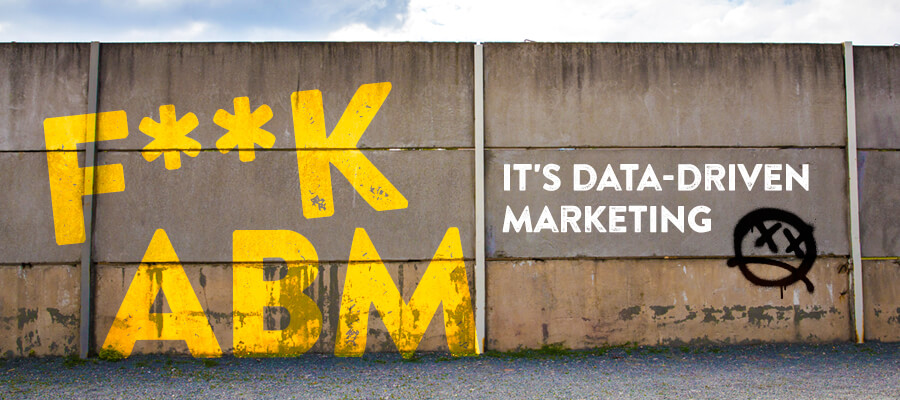2 min read

We’ve all heard a LOT (some would say too much) about Account Based Marketing recently, from clients, agencies and the wider B2B industry as a whole
And ABM’s great, when it’s actually ABM. Those of you who are creating bespoke strategies and propositions that are unique to an account, hats off to you – you’re doing true ABM.
But, for the rest of us, I’d like to re-frame the label we’ve slapped on our latest wave of marketing. Because what many of us are doing isn’t quite ABM, it’s…data-driven marketing.
Why is this important?
Because ‘data-driven marketing’ is much bigger than ABM, and conflating the two is hindering the roll-out of this new way of driving demand. Many companies see ABM as time-consuming, expensive and complex. Data-driven demand generation is not; it’s simply an evolution of the broad-based marketing we’ve always treasured. But ten times more effective.
What is data-driven marketing?
In short, it’s what most of you call scalable ABM, Programmatic ABM or whatever other industry jargon some bright spark has invented. It’s simply the process of using data to target companies that are actually in the market, as opposed to the whole market, with messaging that aligns closer to their needs, through channels that they’re actively using. But you’re still taking a single message to multiple companies rather than multiple messages to multiple companies.
What kind of data is driving this?
Most organisations target based on first-party data. But the opportunity to really optimise your demand generation lies in third-party data, such as intent signals, to build a picture of who wants to buy from you and what they’re looking for – data such as content they’re consuming, websites they’re visiting and channels they’re using to do research.
How do you evolve to data-driven marketing?
- Data
Bring third-party intent data in to your organisation and consider predictive analytics to help you make sense of it. There are lots of intent platforms out there. - SegmentationSegment your message by as many buyer groups as the data indicates, or as many as your resource and budget will allow for.
- ContentRecycle or build new content that aligns to your segmented buyer groups’ needs, as indicated by the data.
- Activation
Activate marketing activity to each of the active accounts, through the channels you’ve aligned them to. Programmatic is commonly considered to continue the scalable approach. - ReportingCreate reporting dashboards that allow you to identify engaged accounts and align follow-up activity accordingly, whether it’s sales follow-up or perhaps ABM activity.
Seems simple right?
It is. The key to data-driven marketing is in the name. Focus on what the data is telling you or, more importantly, what your customer is telling you – and tailor your demand generation to meet their needs.
Use technology to aid you
Technology is critical throughout the data-driven infrastructure. It can help you crunch your data, target your marketing message efficiently and report on your success.
Crap in, crap out
We live in a world of data but it will get us nowhere without the application of creativity. The way you package your message is still paramount, so never expect the technology to do everything.
So are you doing ABM, or data-driven marketing? I’d love to hear your thoughts.
Related content









